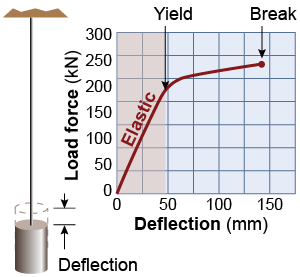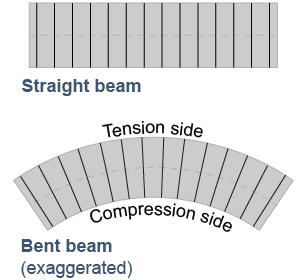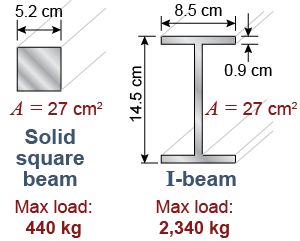|
 The most obvious failure occurs when a part breaks, but failure also occurs when a part deforms past the point where the material “springs back” after the load is removed. Consider a load hanging from a steel cable (as in the graph at right). As the load is increased, the cable stretches like a very stiff spring. Up to a point the steel is elastic, meaning that it springs back when the load is removed. When the load reaches its yield limit, the steel deforms permanently. If the load continues to increase, eventually the steel will break.
The most obvious failure occurs when a part breaks, but failure also occurs when a part deforms past the point where the material “springs back” after the load is removed. Consider a load hanging from a steel cable (as in the graph at right). As the load is increased, the cable stretches like a very stiff spring. Up to a point the steel is elastic, meaning that it springs back when the load is removed. When the load reaches its yield limit, the steel deforms permanently. If the load continues to increase, eventually the steel will break. 
|
 Materials fail when the stress reaches a certain level. Stress is force divided by cross-sectional area, which has units of pressure: N/m2 (pascals or Pa) in SI and lb/in2 (psi) in English units. The tensile strength is the value of stress at which a material typically fails in tension. The tensile strength of plain steel is 250 million N/m2 (MPa) or 25,000 N/cm2. A cable with 1 cm2 area can withstand 25,000 N force before breaking, whereas a thicker 4 cm2 cable can hold up to 100,000 N of force.
Materials fail when the stress reaches a certain level. Stress is force divided by cross-sectional area, which has units of pressure: N/m2 (pascals or Pa) in SI and lb/in2 (psi) in English units. The tensile strength is the value of stress at which a material typically fails in tension. The tensile strength of plain steel is 250 million N/m2 (MPa) or 25,000 N/cm2. A cable with 1 cm2 area can withstand 25,000 N force before breaking, whereas a thicker 4 cm2 cable can hold up to 100,000 N of force. 
|
 Material may also fail in bending. Consider what happens as a beam bends. Material at the center is not deformed at all. Material at the bottom of the beam is compressed. Material at the top of the beam is extended and therefore in tension. The beam fails when the tension stress exceeds the material’s tensile strength at the most highly stressed area, which is the part of the beam farthest away from the center.
Material may also fail in bending. Consider what happens as a beam bends. Material at the center is not deformed at all. Material at the bottom of the beam is compressed. Material at the top of the beam is extended and therefore in tension. The beam fails when the tension stress exceeds the material’s tensile strength at the most highly stressed area, which is the part of the beam farthest away from the center. 
|
 I-beams are often used as structural beams in buildings and bridges. The I-beam makes the most efficient use of material by providing the maximum strength for the minimum weight. In an I-beam, most of the material is placed where the stress is highest—at the top and bottom surfaces. For example, a 100 kg square steel bar 5 m long fails at a load of 440 kg. The same 100 kg of steel formed into an I-beam can handle a load of 2,340 kg!
I-beams are often used as structural beams in buildings and bridges. The I-beam makes the most efficient use of material by providing the maximum strength for the minimum weight. In an I-beam, most of the material is placed where the stress is highest—at the top and bottom surfaces. For example, a 100 kg square steel bar 5 m long fails at a load of 440 kg. The same 100 kg of steel formed into an I-beam can handle a load of 2,340 kg! 
|
| |
|

